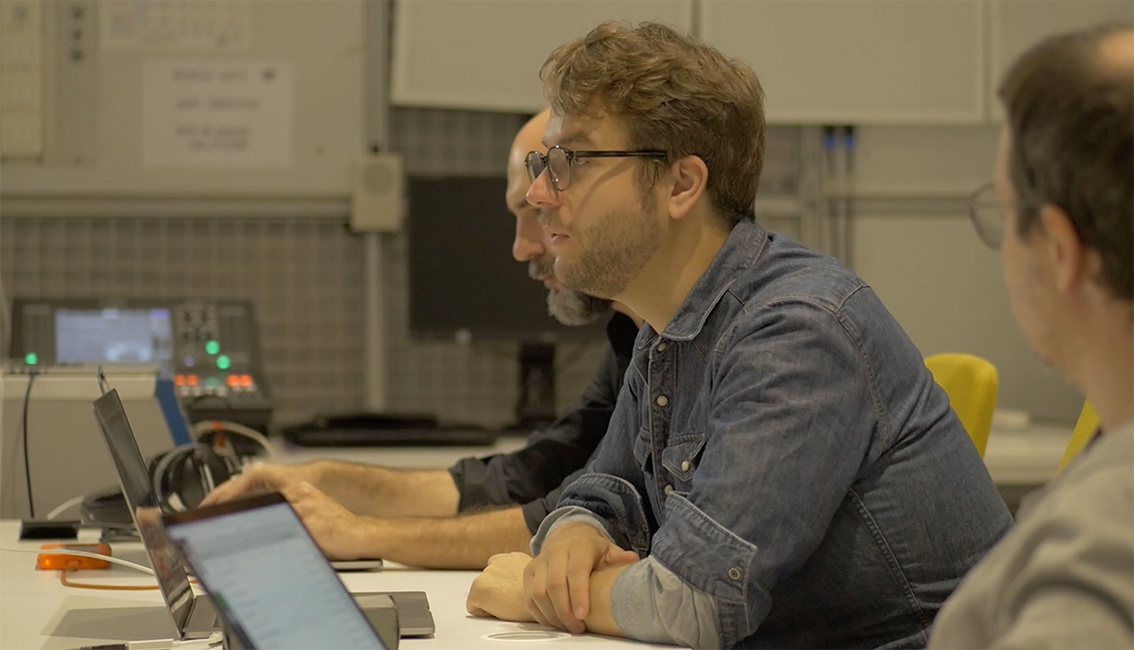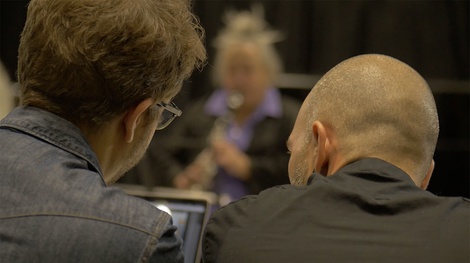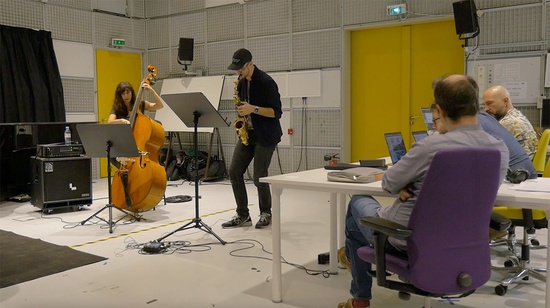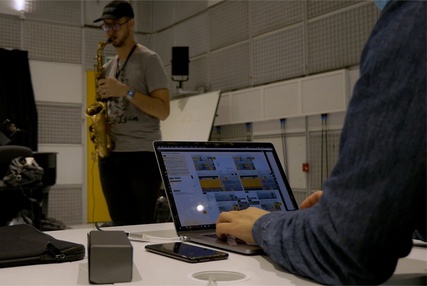In Ex Machina
Collaborant depuis plusieurs années avec le jazzman Steve Lehman, Jérôme Nika est en charge de la création de l'électronique générative et collaborateur artistique du projet Ex Machina élaboré avec l’Orchestre National de Jazz et son chef Frédéric Maurin. Cette création fait grand usage des différentes déclinaisons de DYCI2, « instrument logiciel » issu des recherches qu’il mène depuis près de dix ans en tant que chercheur au sein de l’équipe Représentations Musicales. Si aucun projet ne ressemble à un autre, il observe là avec intérêt ses travaux prendre la dimension à laquelle il aspire depuis l’origine.
 Jérôme Nika, en studio à l'Ircam, capture écran du film Images d'une œuvre n°29 © Ircam - Centre Pompidou
Jérôme Nika, en studio à l'Ircam, capture écran du film Images d'une œuvre n°29 © Ircam - Centre Pompidou
Voilà plusieurs années que vous collaborez avec Steve Lehman : sur quoi ont porté vos travaux jusqu’ici ?
Steve est en effet venu à l’Ircam à de nombreuses reprises, je suis également allé travailler chez lui à CalArts à Los Angeles, et nos échanges se poursuivent même en dehors de ces périodes de résidence. Cette collaboration au long cours associe deux axes de recherche musicale. D’une part, l’exploration des possibilités offertes par la machine pour créer des articulations rythmiques précises entre des sources hétérogènes – par exemple créer des pistes de batterie à la rythmique ciselée, qui suivent précisément la temporalité et le contour prosodique de voix de rappeurs. D’autre part, l’enrichissement spectral de lignes musicales envisagées comme « structures », à partir de « mémoires » de textures complexes – par exemple issues de pièces orchestrales du répertoire contemporain.
Je tiens à préciser que ce travail mené depuis plusieurs années avec Steve s’intéresse aux possibilités génératives de la machine, aussi bien dans un contexte « offline » ou « hors temps », pour la composition en amont de la performance, que dans un contexte « en temps réel » d’interaction improvisée.
Notre collaboration a donné lieu à un duo « Silverlake Studies » présenté pour la première fois au Centre culturel Onassis à Athènes, et que nous prévoyons de présenter à nouveau, ainsi qu’à une installation sonore que j’ai réalisée au Fresnoy en 2019-2020 (et qui sera présentée dans une version réduite pour les journées des Ateliers du Forum Ircam en mars).
Nous nous retrouvons également autour d’une passion commune pour le rap, et nous envisageons une collaboration prochaine avec son groupe Sélébéyone qui comprend, entre autres, deux rappeurs.
Qu’est-ce qui distingue selon vous la démarche adoptée ici par Steve Lehman et Frédéric Maurin vis-à-vis de Dicy2 ?
 La particularité de ce projet est d’abord d’être un formidable terrain de jeu pour combiner les déclinaisons « hors temps » et interactive de Dicy2. À cet égard, leur démarche vis-à-vis de l’outil est la continuation des précédents projets auquel j’ai pu contribuer, mais c’est le premier qui fait un trait d’union entre l’outil génératif « orienté composition », que j’ai commencé à développer dans le cadre de Lullaby Experience avec Pascal Dusapin, et l’outil génératif « orienté interaction » que mes collaborations au long cours avec Steve Lehman ou le saxophoniste Rémi Fox ont largement contribué à construire.
La particularité de ce projet est d’abord d’être un formidable terrain de jeu pour combiner les déclinaisons « hors temps » et interactive de Dicy2. À cet égard, leur démarche vis-à-vis de l’outil est la continuation des précédents projets auquel j’ai pu contribuer, mais c’est le premier qui fait un trait d’union entre l’outil génératif « orienté composition », que j’ai commencé à développer dans le cadre de Lullaby Experience avec Pascal Dusapin, et l’outil génératif « orienté interaction » que mes collaborations au long cours avec Steve Lehman ou le saxophoniste Rémi Fox ont largement contribué à construire.
En intégrant des dispositifs créés à partir de l’environnement Dicy2 dans le processus de composition et dans les improvisations des solistes en temps réel, l’ordinateur devient, tour à tour, un générateur d’orchestrations électroniques pour les compositeurs et un partenaire d’improvisation pour les musiciens.
Cela permet de mettre en application la philosophie de mon projet de recherche, visant à envisager ces deux aspects comme des « mises en temps » différentes de mêmes procédés génératifs, basés sur les mêmes mécanismes – essayant ainsi de dépasser la traditionnelle distinction hors temps/temps réel (peut-être devenue obsolète désormais).

C’est aussi la première fois que « l’instrument d’improvisation » interagira successivement avec une petite dizaine de solistes (d’habitude il s’agit plutôt d’un duo). De ce point de vue, Steve Lehman comme Frédéric Maurin ont décidé de créer des tableaux plus que des parcours lors des interactions soliste-machine : l’idée n’est pas (comme lors les improvisations en duo que je peux faire avec Steve par exemple) de faire évoluer le comportement de la machine pour aller d’un point A à un point B, mais de lui donner un seul comportement « fixe » pour chaque duo avec un ou une soliste, et ainsi créer un tableau dont la musicienne ou le musicien sera la seule ou le seul peintre.
Ce projet se distingue aussi par une autre différence dans l’usage de l’outil génératif « orienté composition », qui relève davantage de l’orchestration.
Photo 1 : Jérôme Nika et Steve Lehman, capture écran du film Images d'une œuvre n°29 © Ircam - Centre Pompidou
Photo 2 : Répétitions d'Ex Machina en studio à l'Ircam, capture écran du film Images d'une œuvre n°29 © Ircam - Centre Pompidou
Quel est votre rôle dans cette production ?
Les instruments électroniques et logiciels que nous utilisons sont ceux que je développe en tant que chercheur au sein de l’équipe Représentations Musicales de l’Ircam et sont issus des recherches auxquelles je contribue depuis bientôt une dizaine d’années.
Au-delà de cet apport scientifique et technologique, ma contribution artistique consiste, auprès des deux compositeurs et avec l’aide de Dionysios Papanicolaou, réalisateur en informatique musicale dédié au projet, en la mise en œuvre de ces instruments pour la création de l’électronique générative : la génération de matériaux pour l’orchestration électronique dans le processus d’écriture, et la composition du comportement des agents interactifs activés lors des improvisations.
Propos recueillis par Jérémie Szpirglas
![]()
Cette action utilise les recherches et logiciels du projet REACH de l’équipe Représentations musicales de l’Ircam dirigé par Gérard Assayag.



